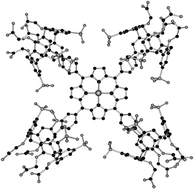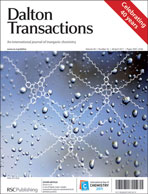Metallated meso-tetrakis(N-methyl-4-pyridyl)porphyrin (MTMPyP) and 5,11,17,23-tetrasulfonato-25,26,27,28-tetrakis-(hydroxylcarbonylmethoxy)-calix[4]arene (C4TsTc) were used as key components for building up discrete supramolecular entities starting from the formation of the template species MTMPyP:C4TsTc (1 : 4, M = Cu, Zn). The stepwise addition of further amount of porphyrin allows the facile non-covalent synthesis of discrete supramolecular entities (2 : 4 and 3 : 4) which can be built up just by programming the right stoichiometric addition of the proper porphyrin. The redox potentials of these supramolecular complexes in aqueous media, as well as those of the parent metalloporphyrins, have been characterized by using square wave voltammetry technique. The use of the simulation procedure leads us to establish the electrochemical steps involved in the redox processes for each supramolecular species, evidencing multistep electron reductions which were not experimentally resolved clearly because of their closeness. The most striking result is that the electrochemistry of each of these supramolecular complexes is different from that of the parent components. This “anomalous” behavior can be explained only considering each of these supramolecular complexes as a unique entity, in which such an internal electronic communication might occur. The formation of the 1 : 4 supramolecular complex produces a negative shift as to the metallated porphyrin redox potentials of about 30 mV. In the case of 2 : 4 and 3 : 4 species, the redox potentials progressively shifts towards more positive values by about 10–15 mV for each complexation step.

You have access to this article
 Please wait while we load your content...
Something went wrong. Try again?
Please wait while we load your content...
Something went wrong. Try again?


 Please wait while we load your content...
Please wait while we load your content...